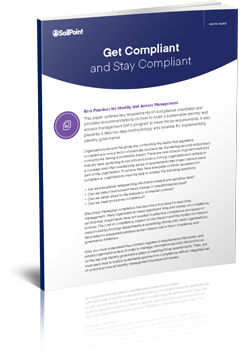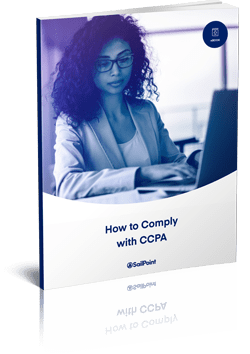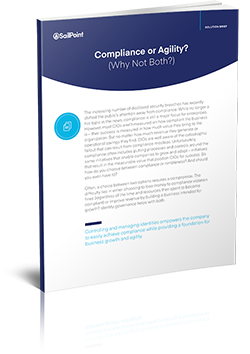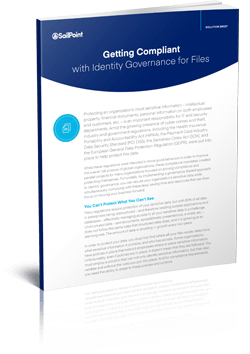Organizations around the globe know that regulatory compliance is a growing factor of everyday business life. Organizations must invest heavily to ensure and prove compliance to a myriad of regulations, including:
- Federal Information Security Management Act (FISMA)
- Sarbanes-Oxley Act (SOX)
- Health Insurance Portability and Accountability Act (HIPAA)
- Payment Card Industry Data Security Standard (PCI DSS)
- EU’s General Data Protection Regulation (GDPR)
- Australia’s Privacy Amendment (Notifiable Data Breaches) Act 2017
- Philippines Personal Data Protection Act (PDPA)
- And many more
How can SailPoint help you comply with CCPA?
Our open cloud identity governance platform makes it easy for you to stay compliant by seeing and controlling access to all your apps and data for every user, including bots.
Understanding compliance.
In general terms, compliance means conforming to an industry standard, policy, rule or law. Regulatory compliance more specifically applies to an organization’s adherence to relevant laws, policies and regulations – as well as the business goals and necessary steps to achieve compliance.
Regulations intended to codify best practices to prevent fraud and improve overall security span a lot of areas of business. One common area is focused on visibility and control over the IT environment. Enterprises need to know who can access what applications, systems and data, who should have access, and what is being done with that access. Additionally, many regulations look for IT controls to enforce corporate policy around these questions.
Yet, according to SailPoint’s 2017 Market Pulse Survey, only 33 percent of respondents could produce a company-wide report within 24 hours demonstrating “who has access to what.”
Also, the cost of non-compliance is significant. Data breaches in regulated industries typically cost much more than breaches in non-regulated industries. Much of those additional costs include notifications, legal action, regulatory penalties and fines.
$5.5M
Compliance
Program Costs
$14.8m
Cost of
Non-compliance
Source: Ponemon Research
Identity is the foundation for security and compliance.
Security and compliance are two sides of the same coin. Compliance with laws and regulations is important for organizations in regulated industries, but it should be the spur that helps you secure your organization’s sensitive applications and data, not the end result. Even organizations that already have a robust security program in place may need some minor adjustments and updated reporting mechanisms to measure, monitor and prove compliance efforts.
While no one in IT can argue against the need to address compliance requirements, it’s crucial for companies not to lose sight of the need to effectively manage IT risk as an overriding driver for both these strategies. When done right, security and compliance are synergistic – working together to protect sensitive data.
This is why organizations should approach strategies for regulatory compliance and reducing overall IT security risks together, through tighter application security efforts, data access control, identity and access management, and related best IT security practices. When those practices are automated and repeatable, not only do risks go down, but security and regulatory compliance costs are also lowered.
Identity governance helps achieve compliance.
Identity governance helps your organization proactively meet and demonstrate compliance requirements. It provides the intelligence and business insights needed to strengthen preventive and detective controls and protect information assets. Identity governance also provides the transparency needed to see “who has access to what” so enterprises can reduce potential security and compliance exposures and liabilities.
The good news is many aspects of identity management can be automated, which cuts the ongoing costs of routine access requests, identity certifications and other reviews. By automating many of these essential processes, IT team members are freed to focus on other aspects of the business. With effective identity governance whenever auditors ask for proof of compliance, companies will have the tools to simply run a compliance report and hand it over. Having this information will show how you are ensuring the right people have the right access to the right data at the right time.
SailPoint’s open identity platform can help your organization:
- Provide proof of compliance to internal and external auditors.
- Proactively detect and revoke inappropriate access and policy violations to strengthen security.
- Enable stronger collaboration and effective governance across business, IT and audit/compliance teams.
- Automatically check access policy before granting new access privileges.
- Unify and centralize access certifications across data center, cloud, and mobile systems.
Implementing an identity governance solution secures your organization’s sensitive data while simultaneously complying with regulations. This ultimately saves your company time and resources, and the focus goes back to moving your business forward, securely and confidently.
How does our open cloud identity governance platform help your business?
We make it possible for you to see and control access to all apps and data for all users, including non-human ones like bots.





